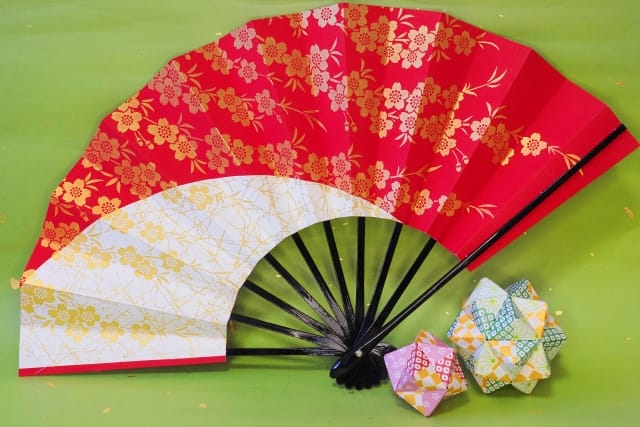Introduction
The Japanese folding hand fan transcends its role as a mere daily utility, emerging as a work of art deeply embedded in the cultural fabric of Japan. Spanning from the Heian period to the modern era, its delicate beauty and functionality have held a special place in Japanese culture. In this article, we will shine a light on the historical background and manufacturing process of the fan, as well as its cultural significance.
We explore how the fan has played a vital role in Japanese culture, tracing its journey from ancient traditional techniques to modern design evolutions. Our exploration also delves into the intricate artwork depicted on these fans and their impact on society and fashion. Through this journey, we will rediscover the fan as more than just a tool for creating a breeze, unveiling the deep cultural value and aesthetic sensibility that lies behind it.
Uchiwa or Sensu ? in Japan
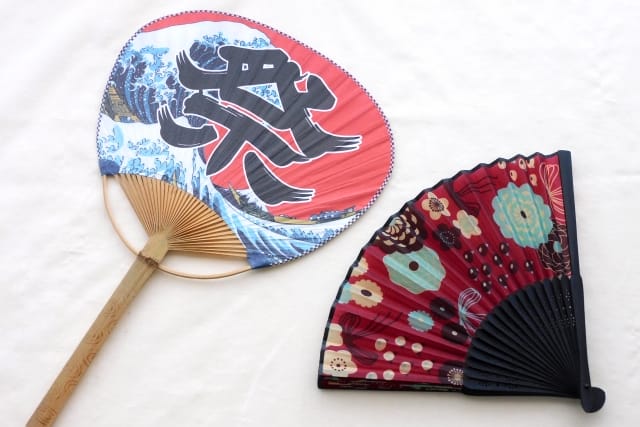
In Japan, folding fans are more commonly used in everyday life, especially in business settings, compared to uchiwa (rigid fans). Particularly among the elderly, carrying a folding fan is seen as a kind of fashion statement. In Japanese companies, while uchiwa may not be acceptable, the use of folding fans is often permitted.
Although uchiwa and folding fans serve similar purposes, they are distinct from each other.
History and Origins (Hand Fans)
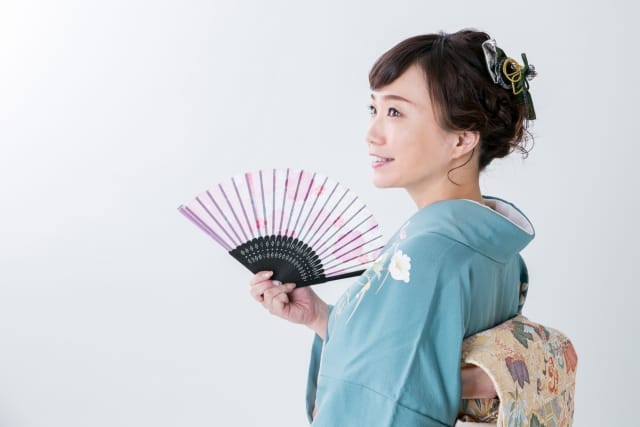
The history and origins of Japanese folding fans (扇子, Sensu) are deeply rooted in the country’s cultural heritage, dating back to the early Heian period (794 – 1185 AD). These fans, traditionally known as Sensu, have been a significant part of Far Eastern society for centuries, initially serving ceremonial, ritualistic, and decorative purposes.
The first Sensu originated in Kyoto about 1200 years ago. Initially, these were not used as cooling devices but as communication tools. Monks and public officials would write notations on slender strips of wood, which were often joined together to form a wooden notebook.
Over time, the practice of drawing pictures on these strips became common, and they started to be used by men and women of various social standings, including nobles and princesses. Fans in Japan have been known to contain important information like rules, court orders, announcements, calendars, prayers, medical transcriptions, and maps.
With the spread of paper use during the mid-Heian period, Sensu began to be popularly used as cooling devices. Kawahori-sen, a decorative paper fan that evolved from Hi-Ougi during the Heian period, was introduced for specific use in the summer. Hi-Ougi, made of thin slats of cypress wood stitched together with silk thread, was typically employed during winter.
There are various types of Sensu, each with its unique purpose and design. These include Hi-ougi, used traditionally in ceremonies by Shinto priests and Imperial Court ladies; Cha-sen, used in the Japanese tea ceremony; Mai-ougi, used in Japanese dance and Kabuki; and Gun-sen, a type of iron and bamboo fan exclusive to military commanders, used as a signalling device, a form of defence, and occasionally as a weapon.
The 15th century saw Japan begin to export their fans to China, eventually reaching Europe and America. This led to the rise of professional fan painters and factories, particularly in Kyoto. The re-importation of these fans to Europe as Kinu-sen, a variety of Sensu made from tightly stretched cloth, occurred towards the end of the Edo period.
After the reopening of Japanese ports in 1854, Sensu and other oriental objects began to flood into Europe, becoming a fashionable accessory among European women of all social classes. This trend was often reflected in the works of French Impressionists, influenced by Japonisme.
Today, while still used for cooling during hot and humid weather, the demand for fashionable Sensu has soared, with various designs, colors, and patterns developed to fit in with the modern market, including prints of popular culture characters.
This rich history underscores the significance of the Japanese folding fan in both Japan’s cultural past and its contemporary society.
Manufacturing Process (How to make Sensu?)


The manufacturing process of Japanese folding fans, particularly the Kyo-Sensu (Kyoto folding fans), is a meticulous and traditional craft that involves numerous steps and skilled artisans. Here is an overview of the process and some interesting aspects of these fans:
- Material Selection and Preparation: Kyo folding fans are made from carefully selected bamboo and either paper or silk. The bamboo used is light and flexible, ideal for the fan ribs. For the fan’s surface, materials are typically sourced from Kyoto and its surrounding areas.
- Detailed Manufacturing Process: The process begins with cutting and splitting bamboo to create the fan ribs. After steaming, the bamboo is finely sliced and shaped. The exterior bark is planed thinly on both sides before leaving the bamboo to dry. In the case of Kyo-uchiwa (another type of Japanese fan), the handle is constructed separately from lacquer and bamboo, and the entire process can take more than a year to complete.
- Artisan Involvement: Each fan involves the collaboration of multiple artisans, each specializing in different steps of the process. For Kyo-Sensu, it is said that about 87 production processes are involved, each requiring craftsmanship and time.
- Varieties and Uses: There is a wide variety of Kyo-Sensu fans, ranging from everyday use to ceremonial purposes. These include natsu-sensu (summer fan), mai-sensu (dance fan), shimai-sensu (used in noh plays), and gishikiyo-sensu (used in ceremonies such as weddings).
- Innovation and Modern Adaptations: Despite their traditional roots, Kyo-Sensu fans continue to evolve. Modern craftspeople are creating innovative designs, including collaborations with anime and introducing fragrances.
- International Influence and Evolution: Historically, the design of Japanese folding fans has been influenced by international styles, such as during the Muromachi period when the sensu adopted the Chinese style of applying paper to both sides. This international exchange led to the evolution of various styles and widespread use in cultural practices like noh theater and the Japanese tea ceremony.
The Kyo-Sensu fans are notable not only for their functional use but also for their role as a cultural icon and a piece of art, reflecting the rich heritage and meticulous craftsmanship of traditional Japanese arts.
Cultural Significance and Uses
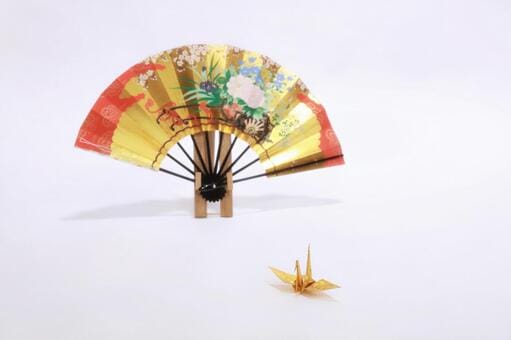
- Traditional Performing Arts: In traditional Japanese performing arts like Noh and Kabuki, fans are integral. They are used to accentuate the movements of performers, adding grace and depth to the performances. Fans can convey emotions and story elements, making them more than just decorative or practical objects in these art forms.
- Tea Ceremony: In the Japanese tea ceremony, fans are used as a symbol of respect. They often rest on the lap of the ceremony’s participants, serving as a decorative piece and a sign of etiquette.
- Festivals and Ceremonies: Fans are a common sight at Japanese festivals (matsuri). They are used both as practical tools for cooling and as part of the ceremonial attire. For instance, during the Gion festival in Kyoto, the ondotori float directors are seen holding Sensu fans, which are considered essential for traditional court attire.
- Religious and Spiritual Significance: In religious settings, such as ceremonies at shrines and temples, fans symbolize purification and spirituality. They are often used in rituals, underscoring their deep-rooted spiritual significance.
- Social and Communication Tool: Historically, Japanese folding fans were also important for communication. People used to write notes, letters, and poetry on fans, especially when paper was a precious commodity. This aspect highlights the fan’s role as a multifaceted object in Japanese society.
- Art and Decoration: The Edo period saw a surge in the artistic use of folding fans, with famous artists creating delicate works on these fans. These artistic fans were also used as decorative pieces in homes, showcasing intricate patterns and paintings.
Symbolism and Artistic Designs
Japanese fans are renowned for their artistic designs. They often feature intricate patterns, paintings, calligraphy, and other artistic expressions, making each fan a unique piece of art. These designs can include seasonal motifs like cherry blossoms, historical events, legends, and poems, each telling a unique story and reflecting Japan’s rich cultural tapestry.
Modern Relevance
In contemporary Japan, the tradition of fans continues. While they are still cherished for their cultural and artistic value, modern designs have also emerged, appealing to the younger generation and tourists. For instance, Kyo-Sensu fans are known for their seamless fusion of beauty and utility, often featuring hand-painted motifs that evoke the seasons.
In summary, Japanese folding fans represent a blend of practicality, artistry, and cultural significance. They are deeply embedded in Japan’s social customs, traditional arts, and religious practices, symbolizing elegance, tradition, and craftsmanship. These fans continue to be a beloved element of Japanese culture, admired both for their beauty and their versatility.
Design and Art
Modern Interpretations and Artists
Contemporary Japanese artists have continued to innovate in the design of sensu, blending traditional motifs with modern aesthetics. One such artist is Takato Yamamoto, known for his unique style that often features intricate, surreal, and sometimes dark themes. His work on folding fans showcases a modern interpretation of traditional Japanese aesthetics, blending classical elements with contemporary art.
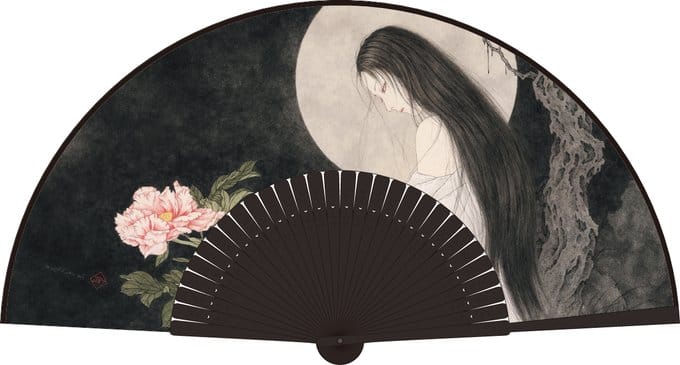
The sensu continues to be an object of fascination and artistic exploration, not just in Japan but globally. Modern artists are experimenting with various materials, designs, and themes, creating fans that appeal to contemporary tastes while honoring the rich history of this unique art form.
Conclusion
The Japanese folding fan stands as a testament to Japan’s enduring commitment to blending functionality with beauty. From being a symbol of status and etiquette in ancient times to its role as a canvas for modern artistic expressions, the sensu remains an integral part of Japanese culture and art.

